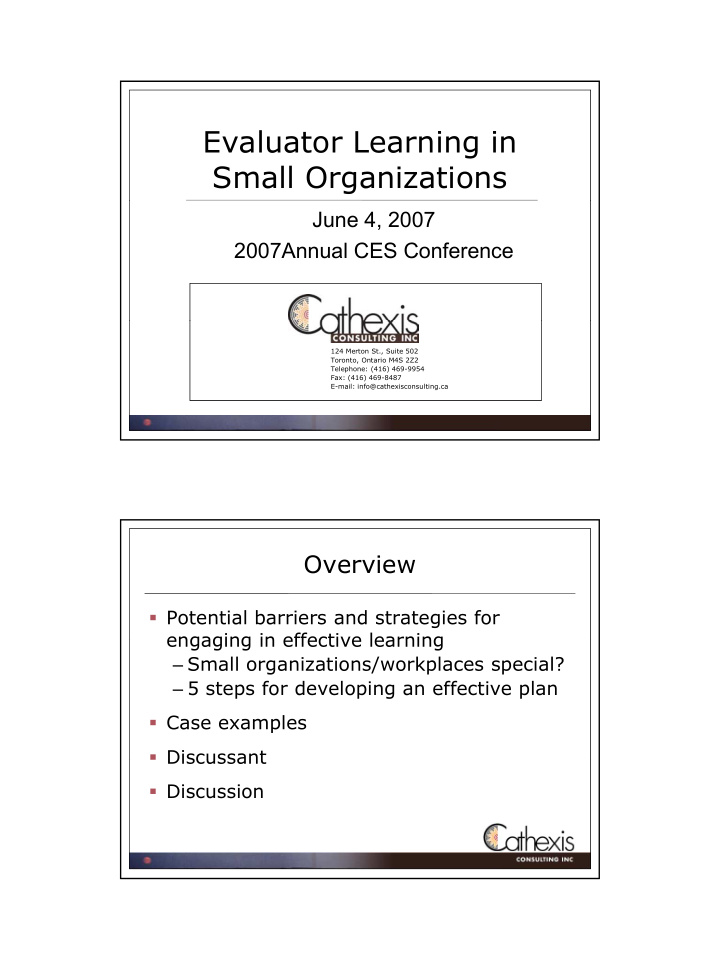



Evaluator Learning in Small Organizations June 4, 2007 2007Annual CES Conference 124 Merton St., Suite 502 Toronto, Ontario M4S 2Z2 Telephone: (416) 469-9954 Fax: (416) 469-8487 E-mail: info@cathexisconsulting.ca Overview � Potential barriers and strategies for engaging in effective learning engaging in effective learning – Small organizations/workplaces special? – 5 steps for developing an effective plan � Case examples � Discussant � Discussant � Discussion 1
The Small Organization/Workplace � Adopts HR solutions as a reaction rather than a strategy (Cassell et al 2002) than a strategy (Cassell et al. 2002) � Less likely to provide formal training due to size specific barriers (Westhead 1998) – access, release time, relevance, financial resources, employer incentives � Prefers informal learning approaches (Dawe & Nguyen 2007) ... Formal training vs. informal learning Formal learning can be identified as learning which follows a pre- learning which follows a pre determined plan, is instructor led, and is monitored and recorded by a training provider. Informal learning, on the other hand, g, , can be understood as initiated by the learner or by the circumstances, to address occurring issues. (compare to Dawe & Nguyen 2007) 2
Informal learning � Traditionally lower status than formal training � Can cope with organizational barriers to formal training � Can often become more effective and reach its potential if structured and use purposefully 1. Identify desirable competencies � Self-assessment tools Ghere Gail; King Jean A ; Stevahn Laurie & Minnema Jane (2006) “A Ghere, Gail; King, Jean A.; Stevahn, Laurie & Minnema, Jane (2006). A – professional development unit for reflecting on program evaluator competencies,” American Journal of Evaluation, 27 (1), pp. 108-123 . – McGuire, Martha & Zorzi, Rochelle (2005). Evaluator competencies and performance development. Canadian Journal of Program Evaluation, 20(2), pp. 73-99. – List: http://consultation.evaluationcanada.ca/pdf/ZorziCESKnowledge.pdf � Check lists Check lists – E.g., www.wmich.edu/evalctr/checklists/ � Discussions with others 3
Some Extracts... 2. Prioritize and set goals � Which competencies are/will be most important for your position? important for your position? � What is your organizations' priorities and anticipated needs? – Learning solution = business solution � Assess your current level (self-assessment � Assess your current level (self assessment tools, tests, performance reviews) 4
3. Understand the context To help selecting strategies that will work: � Supply of formal training opportunities � Organization's informal learning processes E.g., the workplace informal learning matrix: www.wilm.ca/en/index.html – � Learner's personal learning style p g y 3. Understand the context To help selecting strategies that will work: � Potential organizational barriers (small businesses/organizations) – Lacking financial resources – Lacking access – Need for customized learning – Lacking employer incentive 5
4. Select methods and indicators � Revise your goals and make them SMART � Brainstorm strategies, e.g., – Evaltalk; learning networks (internal, cross organizational); teaching; mentoring; reading journals, books, websites; action learning; lunch and learn; peer review committee; formal or informal client or associate feedback � Prioritize and select – make it fit together P i iti d l t k it fit t th – Blended more effective than single 5. Ensure accountability for plan � Initially : build into performance review or other agreement with supervisor/associate agreement with supervisor/associate � Ongoing : Do learning activities meet expectations? If not, make adjustments � 3-6 months after learning activity : Have you integrated learning in practice as planned? If not, make adjustments. k dj t t � Annually : Sum up, evaluate, re-plan 6
References Cassell, C., Nadin, S., Gray, M., & Clegg, C. (2002). Exploring human resource management practices in small and medium sized businesses. Personnel Review, 31(5-6), pp. 671-692. Dawe, S., & Nguyen, N. (2007). Education and training that meets the needs of small businesses: A systematic review of research. Adelaide: National Centre for Vocational Education Research. Gauthier, B.; Borys S.; Kishchuk, N. & Roy, S. (2006). “Evaluation Practice in Canada: Results of a National Survey,” The Canadian Journal of Program Evaluation, 21(3), pp 1-42. Ghere, G.; King, J. A.; Stevahn, L. & Minnema, J. (2006). “A professional development unit for reflecting on program evaluator competencies,” American Journal of Evaluation, 27 (1), pp. 108-123. K earney, P. (2000). Size matters: National summative evaluation report of the Small K earney, P. (2000). Size matters: National summative evaluation report of the Small Business Professional Development Best Practice Program 1669-2000. Hobart: Office of Vocational Education and Training. McGuire, M. & Zorzi, R. (2005). Evaluator competencies and performance development. Canadian Journal of Program Evaluation, 20(2), pp. 73- 99. Storey, D. J., & Westhead, P. (1994). Management Development in Small and Medium- Sized Enterprises with Growth Potential. London: Confederation of British Industry Discussion Questions � What are some examples of informal learning activities you have done? learning activities you have done? � What are some challenges when structuring informal learning approaches? 7
Recommend
More recommend